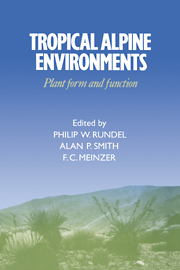Book contents
- Frontmatter
- Contents
- List of contributors
- Preface
- 1 Introduction to tropical alpine vegetation
- 2 Tropical alpine climates
- 3 Páramo microclimate and leaf thermal balance of Andean giant rosette plants
- 4 Comparative water relations of tropical alpine plants
- 5 Cold tolerance in tropical alpine plants
- 6 Anatomy of tropical alpine plants
- 7 Environmental biology of a tropical treeline species, Polylepis sericea
- 8 Morphological and physiological radiation in páramo Draba
- 9 Sediment-based carbon nutrition in tropical alpine Isoetes
- 10 Functional significance of inflorescence pubescence in tropical alpine species of Puya
- 11 Turnover and conservation of nutrients in the pachycaul Senecio keniodendron
- 12 Soil nutrient dynamics in East African alpine ecosystems
- 13 An overview of the reproductive biology of Espeletia (Asteraceae) in the Venezuelan Andes
- 14 Population biology of Mount Kenya lobelias
- 15 Population biology of Senecio keniodendron (Asteraceae), an Afroalpine giant rosette plant
- 16 Population dynamics and flowering in a Hawaiian alpine rosette plant, Argyroxiphium sandwicense
- 17 Plant form and function in alpine New Guinea
- 18 Alpine herbivory on Mount Kenya
- 19 Biotic interactions in Hawaiian high elevation ecosystems
- 20 Tropical alpine ecology: progress and priorities
- Index
4 - Comparative water relations of tropical alpine plants
Published online by Cambridge University Press: 21 October 2009
- Frontmatter
- Contents
- List of contributors
- Preface
- 1 Introduction to tropical alpine vegetation
- 2 Tropical alpine climates
- 3 Páramo microclimate and leaf thermal balance of Andean giant rosette plants
- 4 Comparative water relations of tropical alpine plants
- 5 Cold tolerance in tropical alpine plants
- 6 Anatomy of tropical alpine plants
- 7 Environmental biology of a tropical treeline species, Polylepis sericea
- 8 Morphological and physiological radiation in páramo Draba
- 9 Sediment-based carbon nutrition in tropical alpine Isoetes
- 10 Functional significance of inflorescence pubescence in tropical alpine species of Puya
- 11 Turnover and conservation of nutrients in the pachycaul Senecio keniodendron
- 12 Soil nutrient dynamics in East African alpine ecosystems
- 13 An overview of the reproductive biology of Espeletia (Asteraceae) in the Venezuelan Andes
- 14 Population biology of Mount Kenya lobelias
- 15 Population biology of Senecio keniodendron (Asteraceae), an Afroalpine giant rosette plant
- 16 Population dynamics and flowering in a Hawaiian alpine rosette plant, Argyroxiphium sandwicense
- 17 Plant form and function in alpine New Guinea
- 18 Alpine herbivory on Mount Kenya
- 19 Biotic interactions in Hawaiian high elevation ecosystems
- 20 Tropical alpine ecology: progress and priorities
- Index
Summary
Introduction
In tropical alpine regions drought may be the most important seasonal factor in an environment that otherwise lacks significant seasonality (see Smith, Chapter 1). In many of these regions diurnal cycles of physiological drought associated with low soil temperatures may be superimposed on the seasonal changes in soil moisture. From studies of cold temperate zone plants, particularly conifers (Kaufmann 1975, 1977; Running & Reid 1980), it is known that even in soils near field capacity, water uptake by roots may be severely impaired by low soil temperatures (0–5 °C). This high root resistance to water uptake may extend through spring and into early summer in temperate zone coniferous forests with persistent snow cover. In arctic regions, physiological drought may extend throughout the entire summer if the roots are situated above a permafrost layer (Goldstein 1981).
In the tropical alpine zone, where snow cover is not persistent and permafrost does not exist, the potential for physiological drought is nevertheless present. The risk is especially great during the early morning hours when soil temperatures in the root zone are near freezing and potential transpiration is high due to high solar radiation loads. The simultaneous occurrence of low water availability in the absolute sense on a seasonal basis, and in the physiological sense on a diurnal basis, complicates the analysis of drought resistance mechanisms in tropical alpine plants. It also provides an excellent opportunity to study adaptations to drought along both altitudinal and geographical gradients of relative importance of diurnal versus seasonal drought.
- Type
- Chapter
- Information
- Tropical Alpine EnvironmentsPlant Form and Function, pp. 61 - 76Publisher: Cambridge University PressPrint publication year: 1994
- 13
- Cited by



